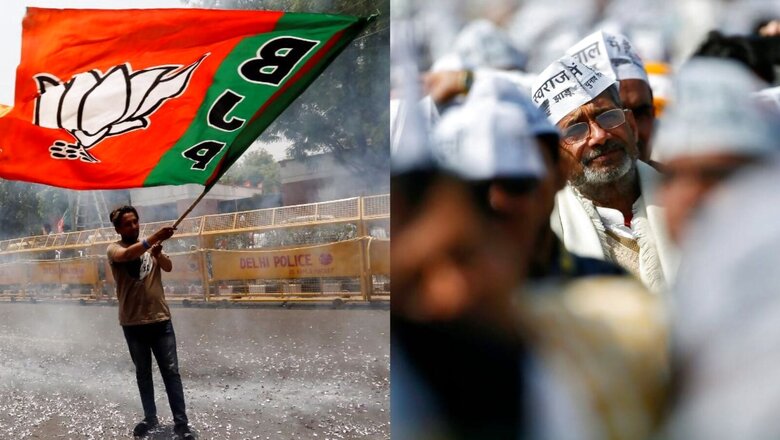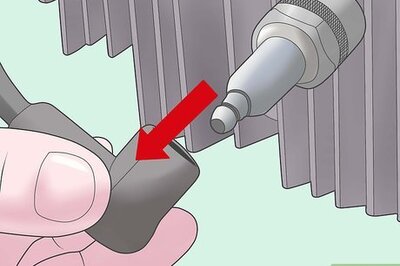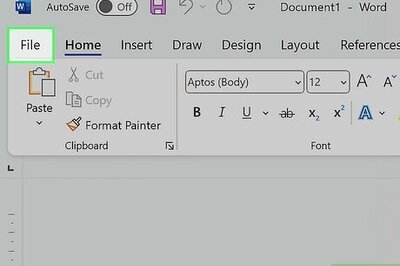
views
As Gujarat polls approach, political watchers are keen on what direction the urban sections of the state will sway in. With AAP in the fray this time, the BJP is looking to bridge the urban-rural divide to its advantage ahead of the assembly elections.
According to figures from the 2011 census, Gujarat is a highly urbanised state with 43% of its residents residing in urban areas. The Lokniti-CSDS states that 182 assembly seats are divided between 98 rural constituencies and 84 semi-urban or urban constituencies. Rural and urban electoral results in the 2017 assembly elections clearly differed. The Bharatiya Janata Party was dominant in urban regions, but Congress significantly outperformed the saffron party in rural areas, said a report by India Today.
Urban Assembly districts in Gujarat have long been a crucial stronghold for the ruling BJP, providing it a commanding advantage in subsequent elections.
However, in addition to the BJP’s usual adversary, the Congress, two more actors, the Asaduddin Owaisi-led All India Majlis-e-Ittehadul Muslimeen (AIMIM) and the Arvind Kejriwal-led Aam Aadmi Party (AAP), are now eager to fight these seats, raising electoral stakes, say reports.
Important for BJP
Since 1998, the BJP has held the position of power in the state. However, in their respective strongholds—urban and rural, respectively—the BJP and Congress each won two-thirds of the seats. The BJP in Gujarat won 63 out of the 84 urban seats in 2017, saving it from defeat. The BJP only managed to win 36 of the 98 assembly seats in rural Gujarat.
In urban areas, the BJP’s strike rate in 2017 was 77%, compared to 87% in the 2012 assembly elections. In comparison, the BJP’s strike rate in rural areas during the most recent assembly elections was only 37%, said a report by India Today.
According to a report by Indian Express, BJP’s “near-total dominance in the urban seats has always been at the heart of the saffron party’s winning streak in Gujarat since 1995”.
In the 2012 Assembly polls, of the state’s total 44 urban seats, the BJP won 40. In Ahmedabad, of the 16 seats, the party won 13. It won all 12 seats in Surat’s urban areas and all five in Vadodara’s urban pockets.
Similarly, it won all four seats, 2 seats each, in Bhavnagar and Gandhinagar. In Rajkot, it won three of four such seats.
AAP’s Entry
The electoral juggernaut of the Aam Aadmi Party is now being closely watched. Political watchers are keen to see if AAP, which is attempting to win over the middle class with promises of changes in electricity, health care, and education, be able to break the BJP’s hold over the region.
Manoj Sorathiya, the general secretary of the AAP in Gujarat was quoted as saying in a VibesofIndia report, that he believed that Arvind Kejriwal is making an impact in both urban and rural sections of the state. Sorathiya thought the middle class, which has been affected by inflation since Covid, should use a fresh perspective. He said that Surat and Gandhinagar local body elections have been the main venues for AAP’s electoral victory.
While AAP is steadily positioning itself as a rival in urban Gujarat, the BJP’s traditional stronghold, political expert Ghanshyam Shah thinks the party won’t become dominant overnight, the report further stated.
BJP leader told the Indian Express that the party did not see any serious Opposition in urban segments, with the exception of certain urban seats where there is minority control, like Jamalpur-Khadia, Dariapur, and Danilimda in Ahmedabad.
According to them, the sectarian violence that occurred in the cities of Ahmedabad, Surat, and Vadodara in the 1980s and 1990s is one of the main causes of this. After then, the BJP took over, and people immediately saw the difference, and that no party even comes close to the BJP in urban areas since communal safety is the main factor for urban voters.
‘AAP a Vote Cutter’: Congress
Paresh Dhanani, a senior member of the Congress, had earlier claimed that the AAP’s entry into the Gujarat Assembly election contest will hurt the governing BJP support among urban and semi-urban voters, thus helping the grand old party. According to Dhanani, the AAP does not have a stronghold in rural regions and would compete with the BJP for 66 urban and semi-urban seats in the state that the Congress has failed to capture in the last 30 years.
Additionally, he claimed that the BJP’s “misrule” had reached its peak and that anti-incumbency was at its height.
“The entry of the third force in the form of AAP and (Arvind) Kejriwalji will benefit Congress the most. We have been facing defeat in Gujarat since the last 27 years as we had not been able to win 66 urban and semi-urban seats in the state. In the last 30 years we have won just one seat of Rajkot twice out of these 66 seats,” Dhanani told PTI.
“In the urban areas, the direct fight will be between BJP and AAP as Congress has not been able to win these seats for the past many years, it will least affect Congress,” the former leader of opposition said.
Elections to the 182-seat Gujarat Assembly will be held by the end of this year. The state will see a three-cornered contest among the BJP, Congress and AAP.
With inputs from PTI
Read all the Latest Explainers here




















Comments
0 comment